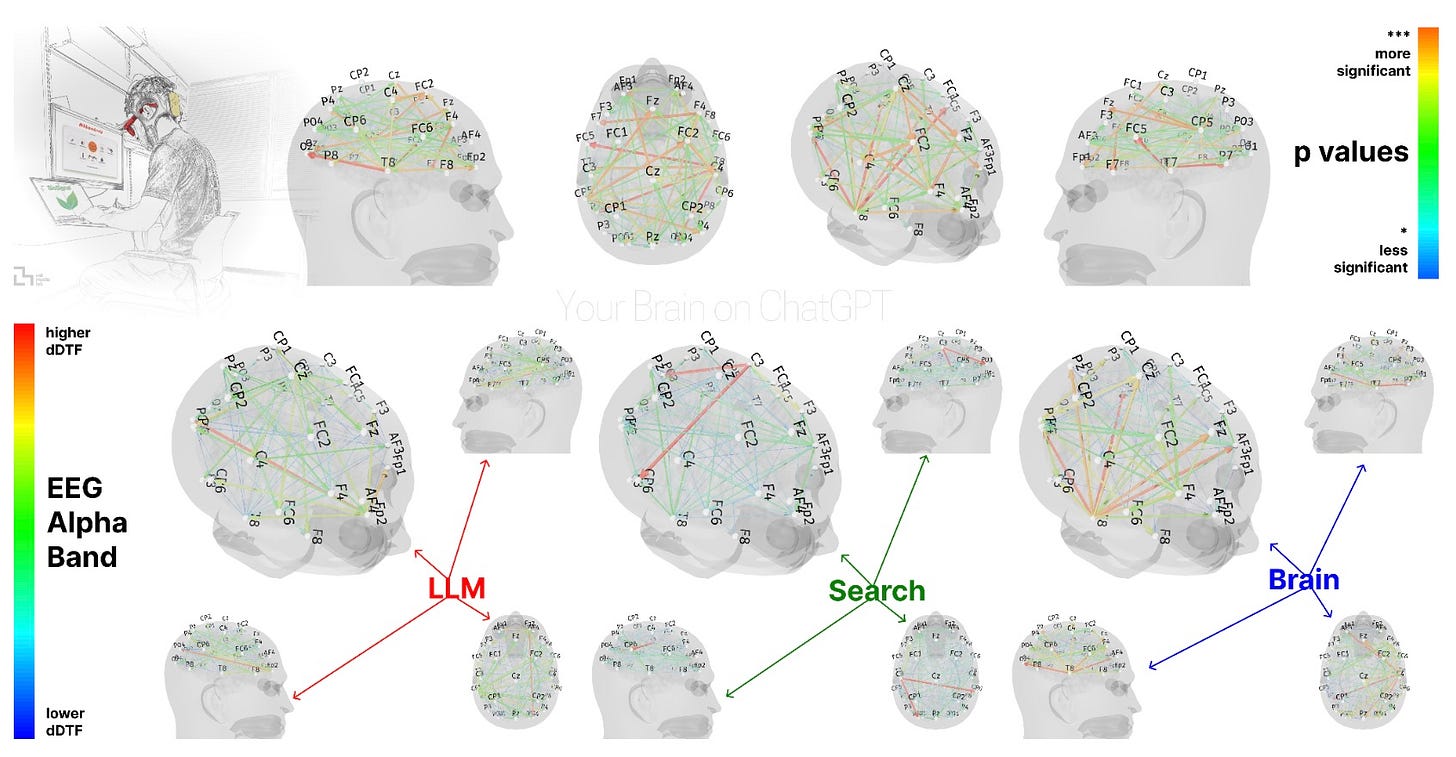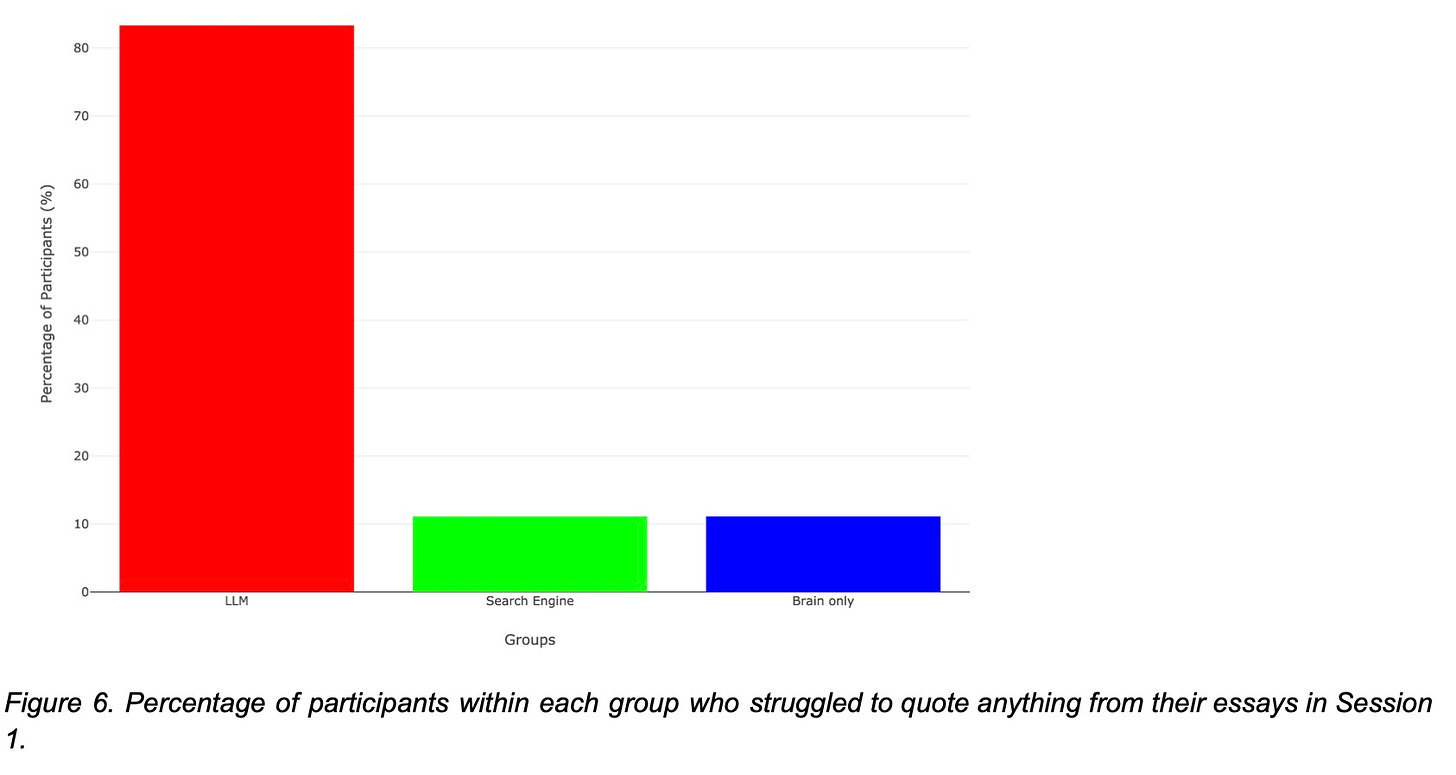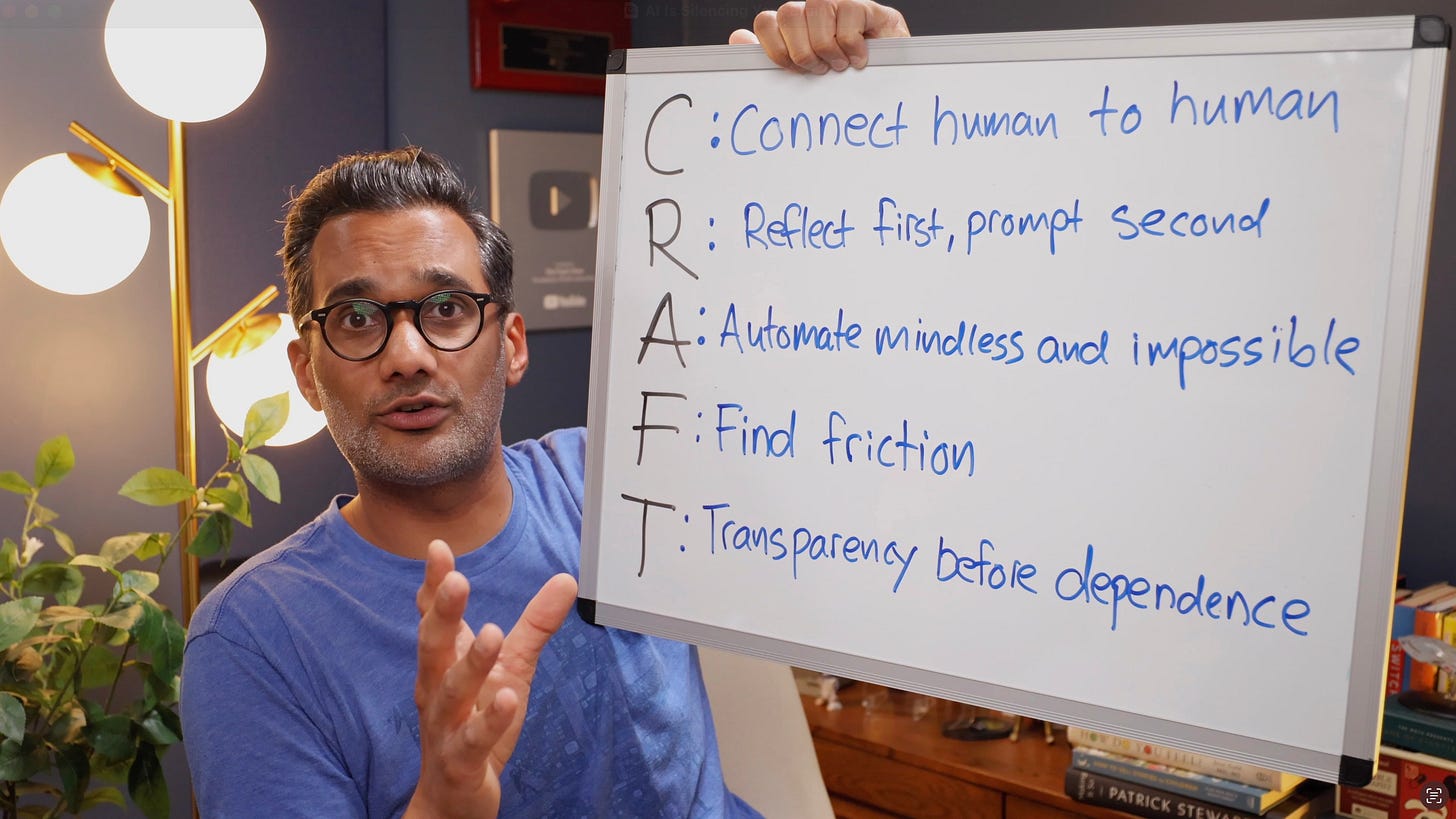When AI Writes, Your Brain Goes Mute
How to think with AI (without letting it think for you)
Dear Curious Human,
Saturday afternoon, my seven-year-old and her best friend burst into my office, crowns crooked, eyes sparkling.
"Daddy, we need a name for our kingdom!"
Two options flickered:
Plop onto the floor with them, toss words around, feel the imagination flow.
Open ChatGPT, type fantasy kingdom names for seven-year-olds, hand them the list, dive back into email.
Exhausted, I chose Door #2. They picked "Lunaria," blessed me with a wand, and scampered away.
And I felt...icky. I'd just outsourced the very muscle I most want my kids to grow: creative play.
That uneasy pit now has data. A brand-new MIT study (not yet peer-reviewed) just confirmed what I suspected: we're training our brains to go dormant.
Researchers wired 54 college students to EEG headsets and had them write SAT-style essays under three conditions:
Brain-only
Brain + Google
Brain + ChatGPT.
Then they measured neural activity, memory retention, and essay quality.
On every metric (engagement, linguistic variety, recall) the ChatGPT group flat-lined.
When conditions flipped, former AI users still showed sluggish brain activity, as if their mental engines never fully restarted.
Most shocking: 83% of AI users couldn't recall a single sentence they'd just "written." The information bypassed their minds entirely, like forwarding an article you never actually read, just because the headline sounded smart.
Cognitive Debt Is Real (and Collecting Interest)
We've been here before, but never this fast:
Printing press → over centuries we stopped memorizing books
Google → over decades, we stopped learning facts we can look up
ChatGPT → over months, we’re outsourcing our thinking
When a LLM model can spit out a passable essay in 0.7 seconds, copy and pasting it feels like the natural thing to do. And every time we lean on it, the bill compounds. Skills atrophy, just like unused muscles.
The CRAFT Playbook
I'm not ditching my AI co-pilot, but I refuse to let it fly solo.
Here's my five-point safety check: CRAFT.
C – Connect human to human
The practice: Write your own emails, texts, birthday notes, especially the ones that need to evoke emotion.
The payoff: Humans crave imperfection. Your typos and awkward phrasing signal "real person here" something AI polish can't fake (yet).
R – Reflect first, prompt second
The practice: Scribble your messy first thoughts before opening the chat box.
The payoff: You stay the author of your ideas instead of becoming an overseer of the machine’s thoughts.
A – Automate the mindless & the impossible
The practice: Let AI handle data crunching, transcription, and busywork you'd never learn from anyway.
The payoff: Save your cognitive calories for work that actually builds your skills and nourishes your soul.
F – Find friction on purpose
The practice: Choose challenges that force slow thinking. Cook without recipes, write longhand, navigate without GPS.
The payoff: Like lifting weights, struggle makes you stronger.
T – Transparency before dependence
The practice: Before trusting AI output, ask: "How does it know this? What might it be missing? Is it just telling me what I want to hear?"
The payoff: Critical thinking is your last line of defense against confident-sounding slop (and there's a lot of it out there).
The Fork in the Timeline
From here, I see three futures:
Dystopia: Thinking-as-a-Subscription
A handful of mega-models sell tiered cognition. The wealthy get premium reasoning. Everyone else gets cognitive scraps.
Utopia: Star Trek Vibes
AI handles drudgery while humans upskill in empathy, meaning-making, and wonder. We become more human, not less.
The Middle Path
We redesign schools, workplaces, and Saturday afternoons so humans draft, AI coaches, and both improve together.
The middle path only opens if we act now. In our classrooms, our offices, our weekends with kids. Next time you reach for the AI shortcut, pause and ask:
Is this the muscle I want to keep strong?
The future isn't inevitable. It's a choice we make, one thought at a time.
With you (brain mostly on),
Dr. Ali
Update: I’ve had a few readers flag real flaws in that MIT paper. This Conversation piece does a great job outlining them.
Top three criticisms of this study:
Practice effect, not “brain rot.”
The AI group wrote only 1 essay without ChatGPT. The brain-only group got 3 opportunities. Less brain only practice → lower brain only performance.Efficiency can look like laziness.
Lower EEG activity may just mean automation. Think calculators, not disengagement.Tiny crossover sample.
Only 18 participants completed the role-swap session, far too small for sweeping claims.
I agree with all that (and, yes, my headline was click-bait). Still, the study matters for one reason: it mirrors what teachers tell me they see right now (i.e. external validity).
Some students do use AI as a coach to improve their work. That’s my goal. But most turn in pure AI slop.
What scares me isn’t the brain activity. It’s the 83 % memory gap. AI users who couldn’t quote a single sentence they’d “written.” That’s a learning blackout.
The culprit isn’t “lazy kids.” It’s stale assignments. If the work feels pointless and can be autopiloted, students will autopilot.
The five-paragraph essay isn’t the gold standard anymore. Long division isn’t modern math. Traditional essays won’t measure modern critical thinking anymore.
AI is advancing at warp speed while our curriculum is stuck in the mud. We need to raise the bar and ask: What uniquely human skills do we want students to learn in an AI world?
Until we answer that, the gap between our tech and our teaching will only grow.




